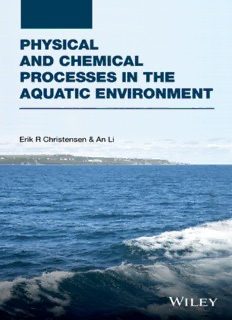
Physical and Chemical Processes in the Aquatic Environment PDF
Preview Physical and Chemical Processes in the Aquatic Environment
PHYSICAL AND CHEMICAL PROCESSES IN THE AQUATIC ENVIRONMENT PHYSICAL AND CHEMICAL PROCESSES IN THE AQUATIC ENVIRONMENT ERIKR.CHRISTENSEN DepartmentofCivilandEnvironmentalEngineering UniversityofWisconsin–Milwaukee ANLI SchoolofPublicHealth UniversityofIllinoisatChicago Copyright©2014byJohnWiley&Sons,Inc.Allrightsreserved PublishedbyJohnWiley&Sons,Inc.,Hoboken,NewJersey PublishedsimultaneouslyinCanada Nopartofthispublicationmaybereproduced,storedinaretrievalsystem,ortransmittedinanyformor byanymeans,electronic,mechanical,photocopying,recording,scanning,orotherwise,exceptas permittedunderSection107or108ofthe1976UnitedStatesCopyrightAct,withouteithertheprior writtenpermissionofthePublisher,orauthorizationthroughpaymentoftheappropriateper-copyfeeto theCopyrightClearanceCenter,Inc.,222RosewoodDrive,Danvers,MA01923,(978)750-8400,fax (978)750-4470,oronthewebatwww.copyright.com.RequeststothePublisherforpermissionshould beaddressedtothePermissionsDepartment,JohnWiley&Sons,Inc.,111RiverStreet,Hoboken,NJ 07030,(201)748-6011,fax(201)748-6008,oronlineathttp://www.wiley.com/go/permission. LimitofLiability/DisclaimerofWarranty:Whilethepublisherandauthorhaveusedtheirbesteffortsin preparingthisbook,theymakenorepresentationsorwarrantieswithrespecttotheaccuracyor completenessofthecontentsofthisbookandspecificallydisclaimanyimpliedwarrantiesof merchantabilityorfitnessforaparticularpurpose.Nowarrantymaybecreatedorextendedbysales representativesorwrittensalesmaterials.Theadviceandstrategiescontainedhereinmaynotbesuitable foryoursituation.Youshouldconsultwithaprofessionalwhereappropriate.Neitherthepublishernor authorshallbeliableforanylossofprofitoranyothercommercialdamages,includingbutnotlimitedto special,incidental,consequential,orotherdamages. Forgeneralinformationonourotherproductsandservicesorfortechnicalsupport,pleasecontactour CustomerCareDepartmentwithintheUnitedStatesat(800)762-2974,outsidetheUnitedStatesat (317)572-3993orfax(317)572-4002. Wileyalsopublishesitsbooksinavarietyofelectronicformats.Somecontentthatappearsinprintmay notbeavailableinelectronicformats.FormoreinformationaboutWileyproducts,visitourwebsiteat www.wiley.com. LibraryofCongressCataloging-in-PublicationData: Christensen,ErikR.,1943- Physicalandchemicalprocessesintheaquaticenvironment/ErikR.Christensen,PhD, distinguishedprofessoremeritus,DepartmentofCivilEngineeringandMechanics,Universityof Wisconsin–Milwaukee,AnLi,PhD,professor,SchoolofPublicHealth,UniversityofIllinoisat Chicago. pagescm Includesbibliographicalreferencesandindex. ISBN978-1-118-11176-5(cloth) 1.Water–Pollution.2.Waterchemistry.I.Li,An,1952-II.Title. TD420.C5252014 628.1–dc23 2014007294 PrintedintheUnitedStatesofAmerica ISBN:9781118111765 10987654321 CONTENTS Preface xi 1 TRANSPORTOFPOLLUTANTS 1 1.1 Introduction, 1 1.2 Advection–DiffusionEquationwithReaction, 2 1.3 Steady-StateMixinginEstuaries, 4 1.3.1 DeterminationofDiffusivityDfromSalinity Measurements, 5 1.3.2 PollutantPredictionforanEstuarywithUniform Discharge, 5 1.3.3 SalinityinanInfiniteEstuarywithaLargeFreshwater Discharge, 8 1.3.4 ConservativePollutantPredictionforanInfiniteEstuary withaLargeFreshwaterDischarge, 9 1.4 Time-DependentMixinginRiversandSoilSystems, 10 1.5 VerticalMixing, 14 1.5.1 TheRadonMethod, 16 1.5.2 TheTritium–helium-3Method, 17 1.5.3 EvaluationofMixingBasedonDensityGradients, 19 1.6 HydrodynamicModels, 20 1.7 GroundwaterPlumes, 22 1.8 SedimentMixing, 23 References, 25 v vi CONTENTS 2 SEDIMENTATIONPROCESSES 28 2.1 Introduction, 28 2.2 210PbDatingofSediments, 29 2.2.1 Measurementof210PbActivity, 30 2.2.2 210PbActivityProfiles, 33 2.3 137Csand239+240PuDatingofSediments, 38 2.4 DatedRecordsofMetalsandOrganicPollutants, 42 2.5 DeconvolutionofSedimentaryRecords, 49 2.6 ChemicalandBiologicalDegradation, 55 2.7 SedimentsasaSourceofPollutants, 56 2.7.1 Phosphorus, 57 2.7.2 Metals, 57 2.7.3 Acid-volatileSulfides, 58 2.7.4 Organics, 59 References, 60 3 ATMOSPHERICINTERACTIONS 65 3.1 Introduction, 65 3.2 AtmosphericDepositionProcesses, 66 3.2.1 Gaseousvs.ParticulateChemicalsintheAtmosphere, 66 3.2.2 DryDepositionwithAerosols, 68 3.2.3 WetDeposition, 75 3.2.4 GasExchange, 78 3.3 DepositionandGasExchangeofOrganicContaminants, 84 3.4 MarineandFreshwaterMicrolayers, 87 3.5 CaseStudy:EmissionofVOCsfromWastewaterTreatmentPlants, 89 3.6 TheFugacityModel, 93 3.6.1 FugacityDefinitionsandBasicEquations, 94 3.6.2 LevelsofComplexity, 101 3.6.3 ExampleCalculations – Chlorobenzene, 103 References, 108 4 WATERCHEMISTRY 113 4.1 Introduction, 113 4.2 CarbonateandAlkalinity, 115 4.2.1 DissolvedCO andCarbonateSpeciationinWater, 115 2 4.2.2 SolvingEquilibriumpH, 117 4.2.3 Alkalinity, 120 4.2.4 BufferIndex, 124 4.3 SulfurChemistry, 127 4.3.1 SulfurRedoxReactionsinWater, 128 4.3.2 SulfurinSediment, 132 CONTENTS vii 4.3.3 AcidRain, 133 4.4 ImpactofGlobalWarmingonNaturalWaters, 135 References, 136 5 NUTRIENTS 138 5.1 Introduction, 138 5.2 InputofNutrientsandAcidity, 140 5.3 Eutrophication, 143 5.3.1 EutrophicationControl, 148 5.3.2 HarmfulAlgalBlooms, 149 5.3.3 Cladophora, 155 5.4 Nitrogen, 156 5.4.1 TheNitrogenCycle, 156 5.4.2 NitrificationandDenitrification, 159 5.4.3 NRemoval, 166 5.5 Phosphorus, 169 5.5.1 ThePhosphorusCycle, 169 5.5.2 PRemoval, 170 5.5.3 CaseStudy:PhosphorusfromWastewaterTreatment, Stormwater,andRiversinMilwaukee,Wisconsin, 172 5.6 VitaminsandTraceMetals, 173 References, 180 6 METALS 185 6.1 Introduction, 185 6.2 Trends,Measurement,andToxicity, 186 6.3 MajorSourcesandReactionsofMetalsinWater, 193 6.3.1 AtmosphericDepositionofMetals, 193 6.3.2 Hydration,Hydrolysis,andComplexFormation, 196 6.3.3 DissolutionofMetalsfromMinerals, 201 6.4 BehaviorofSelectedMetalsinWater, 203 6.4.1 Mercury, 203 6.4.2 ZincandCadmium, 204 6.4.3 Arsenic, 207 6.5 Zero-ValentIroninRemediationofContaminatedWater, 209 6.5.1 DechlorinationofChlorinatedHydrocarbons, 209 6.5.2 ReductionofUraniumCarbonate,Chromate, andArsenate, 214 References, 215 7 ORGANICPOLLUTANTS 220 7.1 Introduction, 220 viii CONTENTS 7.2 ImportantOrganicPollutantGroups, 221 7.2.1 PetrochemicalsandIndustrialSolvents, 221 7.2.2 PolycyclicAromaticHydrocarbons(PAHs), 223 7.2.3 PolychlorinatedBiphenyls(PCBs), 223 7.2.4 PolyhalogenatedDibenzo-p-DioxinsandDibenzofurans (PXDD/Fs), 226 7.2.5 PolybrominatedDiphenylEthers(PBDEs)andotherFlame Retardants, 226 7.2.6 OrganochlorinePesticides(OCPs), 232 7.2.7 OtherPesticides, 236 7.2.8 PerfluorinatedCompounds(PFCs), 239 7.2.9 PharmaceuticalsandPersonalCareProducts(PPCPs)andother EndocrineDisruptingCompounds(EDCs), 240 7.3 DescriptorsofOrganicMolecules, 243 7.4 BasicPhysicochemicalProperties, 245 7.4.1 VaporPressure, 246 7.4.2 AqueousSolubility, 247 7.4.3 Henry’sLawConstant, 248 7.4.4 Octanol–WaterPartitionCoefficient, 248 7.4.5 Air–OctanolPartitionCoefficient, 249 7.5 DistributionofOrganicChemicalsinAquaticEnvironment, 249 7.5.1 Air–Water, 250 7.5.2 Water–Sediment, 250 7.5.3 Water–BiotaandSediment–Biota, 251 7.6 TransformationsinWater, 252 7.6.1 Hydrolysis, 253 7.6.2 PhotochemicalDegradation, 255 7.6.3 BiologicalDegradation, 257 7.6.4 CaseStudy:TransformationofPBDEsintheEnvironment, 259 References, 261 8 PATHOGENS 268 8.1 Introduction, 268 8.2 Bacteria, 271 8.3 Protozoa, 272 8.3.1 Cryptosporidium, 273 8.4 MolecularTechniquesforDetectionofPathogens, 276 8.4.1 Water, 276 8.4.2 Biosolids, 277 8.5 PathogenIndicatorOrganismsandSurrogates, 277 8.5.1 BacillusSubtilis, 280 8.5.2 E.ColiandFecalColiforms, 280 8.6 BacterialContaminationofRecreationalWaters, 281 8.6.1 Modeling, 283
Description: